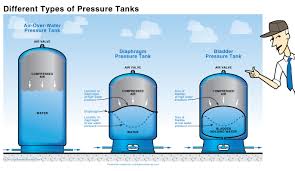Tanks
Water Pressure Tanks: What Are They and How Do They Work?
When you open a
spigot in your home, you expect water to flow at a certain speed.
Water pressure in the
line causes that water to flow. If your home is on city utilities, water
pressure is controlled (for the most part) by the city.
If your home is on a
well, you need something to build that pressure and this is the purpose of the
pressure tank.
In a nutshell: The
pressure tank in a water well system creates water pressure by using compressed
air to bear down on the water.
Because of this
pressure, when a valve is opened water is pushed out of the tank through the
pipes in your home.
 When the water in the
pressures tank drops below the required amount, a pressure switch is activated
turning on the pump.
When the water in the
pressures tank drops below the required amount, a pressure switch is activated
turning on the pump.
The pump then refills
the pressure tank. The combination of the pressure tank, pressure switch and
the pump is what allows water to flow through your home.
Pressure tanks, which
also act as reservoirs for the home, are generally set to keep pressure within
20 pounds per square inch (PSI) of your starting and stopping parameters.
For example, most
homes have pressure of 40 PSI to 60 PSI. If the pressure drops below 40 PSI,
the pump kicks on and brings the pressure back to 60 PSI before cutting off
again.
Because the tank acts
as a reservoir, it allows water to be drawn from the tank without the pump
cycling on and off each time the water is turned on.
This ultimately
protects and prolongs the lifespan of the pump.
Pressure tanks also
reduce instances of water
hammer as they reduce air in
the pipes and control the pressure of the water.
 When choosing a
pressure tank you will need to know the gallons per minute (GPM) – or if they
ask for gallons per hour (GPH) just multiple that number by 60 – your pump
pushes water through your pipes.
When choosing a
pressure tank you will need to know the gallons per minute (GPM) – or if they
ask for gallons per hour (GPH) just multiple that number by 60 – your pump
pushes water through your pipes.
You’ll also need to
count the number of plumbing fixtures, including outside spigots, the system
needs to service.
Most manufacturers
provide a chart to help you size your pressure tank.
Like everything, if
in doubt, it’s always better to go with larger pressure tanks and have them
installed by a professional.
.
RELATED POSTS:
RELATED POSTS:
.
.
CLICK HERE . . .
CLICK HERE . . .
.
CLICK HERE . . .
.
CLICK HERE . . .
 |
Multi-Media Filter, Highly-Activated Carbon Filter,
Zeolite-Process Water Softener With Brine Tank,
Fiberglass Ballast-Type Pressure Tank
(fully automatic backwash & regeneration)
|
PURICARE
Water
Treatment
Systems
.
.
...
Aganan, Pavia, Iloilo, Philippines
...
CLICK HERE . . . to view company profile . . .
CLICK HERE . . . to view company profile . . .
 |
| Industrial Water Treatment Systems |
 |
| Water Treatment Systems for Large-Scare Poultry Tunnel Ventilation |
 |
VENTILATION AND COOLING SYSTEMS FOR POULTRY FARMS |
 |
| Tachmina Laminated Sand Filter |






Sewage Treatment Plant in Delhi controls the spread of sicknesses. Leftover squanders from medical clinics, research offices just as different ventures can be hard for our wellbeing and the climate. These destructive components may require warm treatment for controlling the spread of infections or poisons. Sewage slime burning diminishes the volume of up to 90% and weight up to 75% and separates hazardous substances like harmful and microorganism synthetics. Pipe gases from exhaust pipes must be taken care of by utilizing an intricate treatment framework to keep risky discharges and remains from tainting the climate.
ReplyDelete